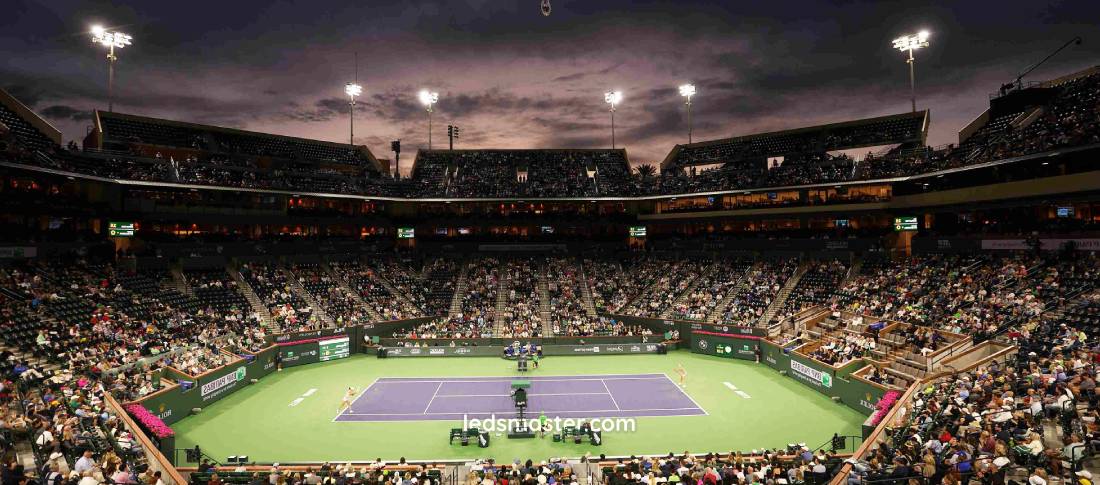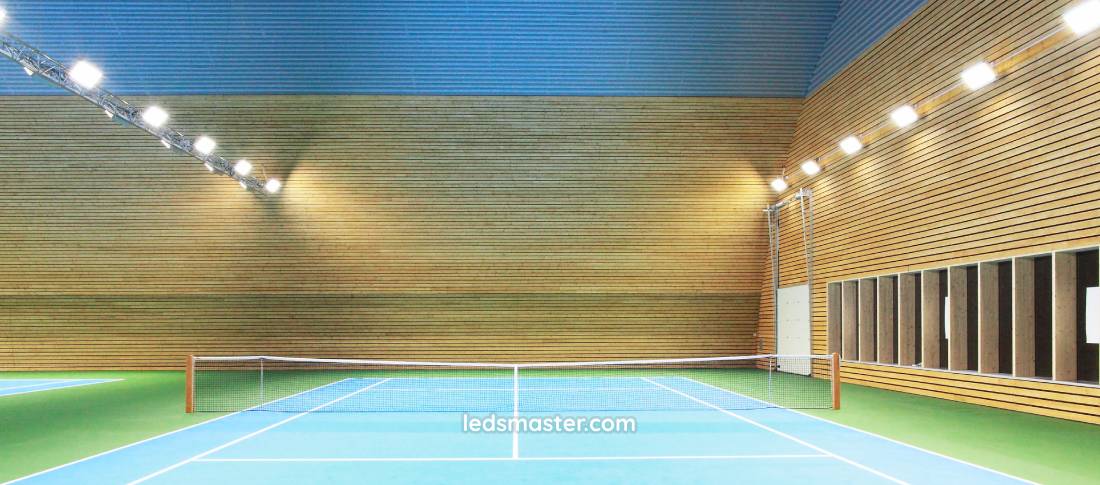Whether you’re setting up an indoor facility or illuminating an outdoor court, understanding color temperature is crucial for enhancing visibility and player performance. Explore our expert insights and recommendations to create an optimal playing environment that shines bright for every match!
Get your complimentary lighting design today
Choosing the right color temperature create a vibrant and high-performing tennis environment. The perfect lighting enhances visibility, reduces glare, and boosts player comfort, ensuring every match is a winning experience. Explore our expert insights and tailored solutions to find the ideal lighting for your indoor or outdoor courts.
Among the various aspects of lighting design, color temperature influences visibility, player performance, and overall ambiance. This article explores the essential considerations regarding color temperature for tennis court lighting, focusing on recommended color temperatures for both indoor and outdoor courts, the impact of color temperature on visibility, a comparison of color temperatures, relevant lighting standards, and energy efficiency considerations.

Table of Contents
ToggleIndoor tennis courts offer a controlled environment where lighting remains unaffected by external elements such as sunlight or weather conditions. This stable setting allows for a softer, warm white lighting that can enhance visual comfort while providing sufficient brightness for game clarity. The recommended color temperature range for indoor tennis courts typically lies between 3000K and 4000K, which generates a warm white light. This light range not only creates an inviting atmosphere but also minimizes glare and reduces eye strain, essential factors in environments where players engage in prolonged games.
A color temperature of 3000K to 4000K emits a softer, more comfortable light that contributes to the inviting ambiance of indoor tennis courts. This warmer light tone reduces the harshness that can occur with higher color temperatures, creating a more relaxed visual experience for players and spectators. The controlled indoor environment permits this type of lighting without concerns about competing with ambient daylight or dealing with sudden light shifts.
Soft lighting also helps players stay visually comfortable, especially during extended play. For indoor tennis courts, maintaining a color temperature in this range provides enough brightness without the need for extremely high-intensity light. This approach reduces the risk of visual discomfort or eye strain while still supporting clear visibility of the court surface, lines, and net.
While the warmth of 3000K to 4000K lighting provides comfort, visibility remains optimal for tracking fast-moving objects, such as tennis balls, during gameplay. Too much warmth in the lighting can potentially reduce contrast, which may impact players’ ability to track the ball quickly. Consequently, indoor lighting solutions should balance warmth with sufficient brightness to ensure clarity and ease of play. In professional indoor settings, lighting systems are sometimes designed with adjustable brightness to allow for tailored levels based on match requirements.
For recreational indoor courts, a consistent color temperature within this range is typically adequate, ensuring that players of all skill levels enjoy a comfortable and visually supportive playing environment. By choosing the right level of warmth, indoor court lighting can enhance the overall play experience without compromising visibility.
Outdoor tennis courts have different lighting requirements due to their exposure to natural light and varying weather conditions. Unlike indoor courts, where lighting remains constant, outdoor courts may need to compete with or supplement natural sunlight, especially during evening matches. To ensure clear visibility in outdoor settings, lighting with higher color temperatures—typically between 4000K and 5000K, and sometimes up to 6000K—is generally recommended. This cooler, daylight-like lighting is crucial for providing the level of brightness and contrast required for effective play.
Cooler color temperatures (4000K to 6000K) mimic the brightness and sharpness of natural daylight, allowing outdoor courts to remain well-lit even in low-light conditions or during evening matches. The crisp, intense light provides a high level of contrast, making it easier for players to see the ball and track its movement accurately. Higher color temperatures also prevent shadows and dark spots, which could interfere with players’ depth perception and judgment.
In competitive environments, where split-second decisions are vital, the increased clarity offered by cool white or daylight lighting gives players a crucial edge. Furthermore, the cool light enhances the court’s uniformity, ensuring that all parts of the court are evenly illuminated for fair play.
Outdoor courts must often contend with fluctuating natural light, so lighting solutions should be adaptable to varying conditions. For instance, lights with a color temperature around 5000K or 6000K create an effective balance that can accommodate changes in daylight, transitioning smoothly from daytime to evening play. In some cases, advanced lighting systems are installed with dimmable or adjustable features, allowing operators to modify the intensity or color temperature as the light changes throughout the day.
In recreational or public outdoor courts, consistency in color temperature provides reliable lighting for players at all hours. The cooler color temperature ensures players can maintain visual clarity without straining their eyes, even as the surrounding light conditions vary. This adaptability is a significant asset, enabling players to perform their best, regardless of the time of day or weather conditions.
The selection of color temperature impacts more than just the brightness or warmth of the light; it affects how players perceive objects on the court, including the ball, the net, and other players. These visual factors can influence player comfort, reaction time, and overall performance.
For indoor tennis courts, warmer lighting within the 3000K to 4000K range offers a comfortable and relaxed visual environment. While this warm white light can sometimes reduce contrast slightly, it fosters a visually pleasant experience that minimizes glare and supports prolonged play without causing eye fatigue. The warm light enhances the ambient feel of the space, providing a welcoming experience for players and spectators alike.
In recreational settings, warmer light helps players feel more at ease and relaxed, allowing them to enjoy the game without the intensity of cooler lighting. However, it is essential that lighting designers account for the need to balance warmth with brightness, ensuring that visibility remains uncompromised despite the softer color temperature. When well-balanced, warm lighting can offer both visual comfort and sufficient clarity for effective indoor play.
Outdoor tennis courts require cooler lighting that supports high visibility and contrast. A color temperature of 4000K to 6000K offers a clear and bright white light that enhances visibility across the entire court. This brightness and intensity help players track the ball’s movement accurately, even during evening or nighttime matches. Cool white and daylight lighting provide the crispness necessary for observing fast-paced play and making quick decisions.
This type of lighting reduces shadows and creates uniform illumination across the playing surface, which helps maintain a consistent visual environment. For outdoor courts, where conditions can change quickly, higher color temperatures are especially practical, as they mimic the natural light’s brightness, creating an environment that feels familiar to players and allows them to adjust easily from day to night.
Color temperatures are often divided into three main categories: warm white, cool white, and daylight. Each type serves a different purpose on tennis courts and affects the ambiance, visibility, and functionality of the lighting.
Warm white lighting, around 3000K, emits a soft and inviting glow that suits indoor environments. This color temperature fosters a cozy atmosphere, creating a comfortable environment for recreational and casual play. However, its softer illumination may not provide the level of brightness required for fast-paced games. While warm lighting can enhance visual comfort, it should be balanced with adequate brightness to avoid reducing the visibility needed to track the ball and court lines.
Cool white lighting, in the range of 4000K to 5000K, provides a balanced option for both indoor and outdoor settings. This color temperature is bright enough to support outdoor play but maintains a comfortable level of warmth that works well indoors. For mixed-use facilities or courts that switch between recreational and competitive play, cool white lighting offers the flexibility to cater to various lighting needs without overwhelming players or reducing visibility.
Daylight color temperatures exceed 5000K and are typically used in outdoor courts where clarity and visibility are paramount. This lighting replicates natural sunlight, providing a bright, intense illumination that enhances player performance and focus. Daylight lighting is especially effective during late afternoon or evening matches when natural light begins to fade, as it ensures the court remains well-lit, allowing for high-stakes play to continue without visual compromise.
Creating an optimal lighting environment for tennis courts requires adherence to established lighting standards and guidelines. Various organizations, such as the United States Tennis Association (USTA), provide recommended lighting levels and color temperature ranges to create safe and high-performance court environments. Compliance with these guidelines helps ensure that lighting systems meet both safety and functional requirements.

Energy efficiency is another consideration when selecting tennis court lighting, particularly given the increasing focus on sustainability. Higher color temperatures, especially those found in LED fixtures, not only provide superior illumination but also contribute to energy savings. LED lights can deliver significant energy efficiency benefits compared to traditional incandescent or halogen bulbs, which often consume more power while providing less effective illumination.
Additionally, energy-efficient lighting solutions can lead to lower operational costs over time. While the initial investment for LED fixtures may be higher, their longevity and reduced energy consumption make them a cost-effective choice in the long run. Moreover, many municipalities offer incentives for installing energy-efficient lighting, further promoting the adoption of sustainable practices within sports facilities.
Lighting standards are designed to support player safety, reduce the risk of accidents, and promote consistent visual experiences across all types of courts. By adhering to these standards, court owners can guarantee that lighting systems deliver adequate brightness and uniformity while also providing the recommended color temperature. Standardized lighting levels help create predictable, reliable court conditions, which is particularly valuable in professional settings where consistency is crucial.
Standards may vary based on the type of play and the intended use of the court. Recreational facilities might adhere to minimum lighting recommendations for general use, while competitive venues typically require higher levels of illumination and stricter adherence to uniformity and color temperature standards. Adopting the appropriate lighting guidelines ensures that players can enjoy a safe and optimal playing experience while also minimizing visual distractions and maximizing performance.
Color temperature is a fundamental aspect of tennis court lighting that influences player visibility and overall performance. By understanding the recommended color temperatures for indoor and outdoor courts, recognizing the impact of color temperature on visibility, comparing different color temperatures, adhering to lighting standards and regulations, and considering energy efficiency, court owners can create a safe, enjoyable, and sustainable environment for players. With the right lighting solutions in place, tennis courts can shine brightly, enhancing the game for all who step onto the court.